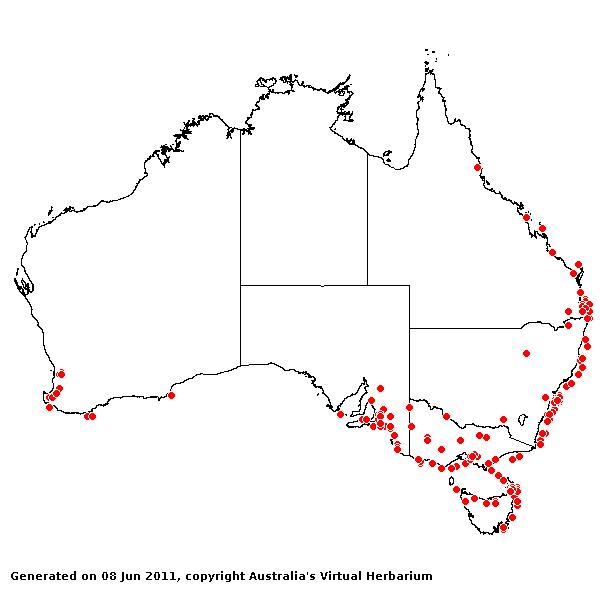Stenotaphrum secundatum* (Walt.) Kuntze. Rev. Gen. Pl. 2: 794 (1891).
Classification. (GPWG 2001) : Subfamily Panicoideae. Paniceae.
Basionym and/or Replacement Name: Ischaemum secundatum Walter, Fl. Carol. 249 (1788).
Type of Basionym or Protologue Information: USA: South Carolina, Walter s.n. (HT: BM).
Key references (books and floras): [1878] G.Bentham, Flora Australiensis 7 (500 as Stenotaphrum americanum), [1952] C.A.Gardner, Flora of Western Australia 1 Gramineae (245), [2002] D.Sharp & B.K.Simon, AusGrass, Grasses of Australia, [2002] J.Wheeler, N.Marchant & M.Lewington, Flora of the South West (436), [2006] J.Jessop, G.R.M.Dashorst, F.M.James, Grasses of South Australia (490), [2008] S.W.L.Jacobs, R.D.B.Walley & D.J.B.Wheeler, Grasses of New South Wales (380).
Illustrations: [1984] N.T.Burbidge. rev. S.W.L.Jacobs, Australian Grasses (249), [2006] J.Jessop, G.R.M.Dashorst, F.M.James, Grasses of South Australia (489, fig. 423), [2008] S.W.L.Jacobs, R.D.B.Whalley & D.J.B.Wheeler, Grasses of New South Wales, 4th edn (380).
Habit. Perennial. Rhizomes present. Stolons present. Culms prostrate, 10–40 cm tall. Ligule a fringe of hairs, 0.4–0.6 mm long. Leaf-blades linear, conduplicate, 2–15 cm long, 4–15 mm wide.
Inflorescence. Inflorescence solid, a raceme. Racemes sunken, 0.5–1 cm long, bearing 1–3 fertile spikelets on each. Central inflorescence axis 2–10 cm long.
Spikelets. Spikelets sessile. Fertile spikelets 2-flowered, the lower floret barren (rarely male), the upper fertile, comprising 1 basal sterile florets, comprising 1 fertile floret(s), without rachilla extension, oblong, dorsally compressed, 4–5.1 mm long.
Glumes. Glumes dissimilar, thinner than fertile lemma. Lower glume ovate, membranous, without keels. Upper glume ovate, 4–5 mm long, membranous, without keels, 7–9 -nerved. Florets. Basal sterile florets 1, male, with palea. Lemma of lower sterile floret 100 % of length of spikelet, coriaceous, 7–9 -nerved.
Fertile lemma 3.8–4.5 mm long, without keel, 5 -nerved.
Continental Distribution: Europe, Africa, Temperate Asia, Australasia, Pacific, North America, and South America.
Australian Distribution: Western Australia, Northern Territory, South Australia, Queensland, New South Wales, Victoria, Tasmania, Norfolk I, Lord Howe.
Western Australia: Dampier. Drummond, Menzies. Northern Territory: Central Australia South. South Australia: Eyre Peninsula, Yorke Peninsula, Southern Lofty, Kangaroo Island, South-eastern. Queensland: Cook, Darling Downs, Moreton, Port Curtis, South Kennedy, Wide Bay. New South Wales: North Coast, Central Coast, South Coast, South-Western Slopes. Victoria: East Gippsland, Eastern Highlands, Gippsland Plain, Grampians, Lowan Mallee, Midlands, Murray Mallee, Otway Plain, Otway Range, Wilsons Promontory, Riverina, Volcanic Plain, Wannon, Wimmera. Tasmania: King Island, Furneaux Group, North West, North East, West Coast, Midlands, East Coast.
Notes. Commonly associated with coastal areas where the mode of disarticulation assists with dispersal.
Introduced; in tropical heaths, tropical and subtropical rain forests, temperate rain forests, tropical and subtropical wet sclerophyll forests, dry sclerophyll forests, tropical and subtropical sub-humid woodlands, and temperate sub-humid woodlands. Cultivated as a lawn grass in the tropics and warm temperate regions of the world. Flowers throughout the year.



